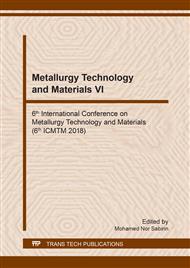[1]
Menezes P L, Rohatgi P K, Lovell M R. Self-Lubricating Behavior of Graphite Reinforced Metal Matrix Composites[J]. Green Energy & Technology, 2012, 49:445-480.
DOI: 10.1007/978-3-642-23681-5_17
Google Scholar
[2]
Zhu S, Bi Q, Yang J, et al. Influence of Cr content on tribological properties of Ni3Al matrix high temperature self-lubricating composites[J]. Tribology International, 2011, 44(10):1182-1187.
DOI: 10.1016/j.triboint.2011.05.014
Google Scholar
[3]
Bewlay B P, Jackson M R, Subramanian P R, et al. A review of very-high-temperature Nb-silicide-based composites[J]. Metallurgical & Materials Transactions A, 2003, 34(10):2043-(2052).
DOI: 10.1007/s11661-003-0269-8
Google Scholar
[4]
Li J, Xiong D. Tribological properties of nickel-based self-lubricating composite at elevated temperature and counterface material selection[J]. Wear, 2008, 265(3–4):533-539.
DOI: 10.1016/j.wear.2007.09.005
Google Scholar
[5]
Sliney H. The Use of Silver in Self-Lubricating Coatings for Extreme Temperatures[J]. ASLE Transactions, 1986, 29(3):370-376.
DOI: 10.1080/05698198608981698
Google Scholar
[6]
Sliney H E, Dellacorte C. The friction and wear of ceramic/ceramic and ceramic/metal combinations in sliding contact[J]. Journal of the Society of Tribologists and Lubrication Engineers; (United States), 1994, 50:7(7):571-576.
Google Scholar
[7]
Wang Q H, Xue Q J, Liu W M, et al. The friction and wear characteristics of nanometer SiC and polytetrafluoroethylene filled polyetheretherketone[J]. Wear, 2000, 243(1):140-146.
DOI: 10.1016/s0043-1648(00)00432-4
Google Scholar
[8]
Ren S, Yang S, Zhao Y, et al. Friction and Wear Studies of Octadecyltrichlorosilane SAM on Silicon[J]. Tribology Letters, 2002, 13(4):233-239.
Google Scholar
[9]
Fusaro R, Sliney H. Lubricating Characteristics of Polyimide Bonded Graphite Fluoride and Polyimide Thin Films[J]. ASLE Transactions, 1972, 16(3):189-196.
DOI: 10.1080/05698197308982721
Google Scholar
[10]
Du L, Zhang W, Liu W, et al. Preparation and characterization of plasma sprayed Ni3Al–hBN composite coating[J]. Surface & Coatings Technology, 2010, 205(7):2419-2424.
DOI: 10.1016/j.surfcoat.2010.09.036
Google Scholar
[11]
Yao J, Shi X, Zhai W, et al. Influence of Lubricants on Wear and Self-Lubricating Mechanisms of Ni3Al Matrix Self-Lubricating Composites[J]. Journal of Materials Engineering & Performance, 2015, 24(1):280-295.
DOI: 10.1007/s11665-014-1266-3
Google Scholar


